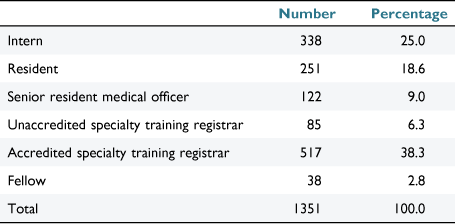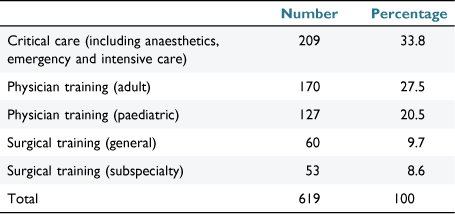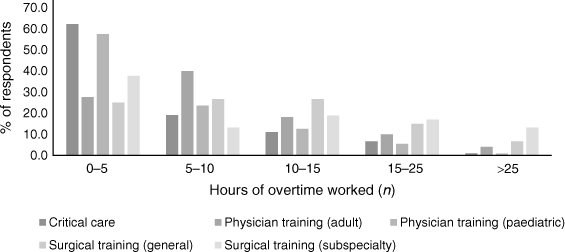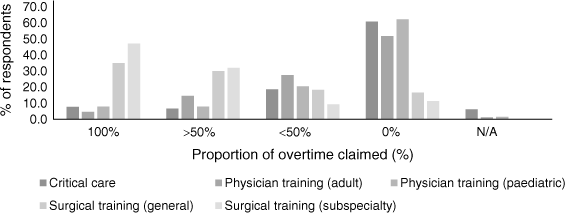Overtime claiming among Australian doctors-in-training
Andrew Coulshed A * , Brian Fernandes
A * , Brian Fernandes  A and Sanjay Hettige B
A and Sanjay Hettige B
A Royal Prince Alfred Hospital, University of Sydney, 50 Missenden Road, Camperdown, NSW 2050, Australia.
B Nepean Hospital, University of Sydney, Derby Street, Kingswood, NSW 2747, Australia.
Australian Health Review 46(2) 163-169 https://doi.org/10.1071/AH21323
Submitted: 29 July 2021 Accepted: 20 January 2022 Published: 22 March 2022
© 2022 The Author(s) (or their employer(s)). Published by CSIRO Publishing on behalf of AHHA. This is an open access article distributed under the Creative Commons Attribution-NonCommercial-NoDerivatives 4.0 International License (CC BY-NC-ND)
Abstract
Objective To quantify patterns of overtime among doctors-in-training in New South Wales and to explore the reasons doctors-in-training cite for not claiming overtime worked.
Methods A confidential online self-reporting survey was conducted of post-graduate doctors-in-training, working in hospitals in NSW, from post-graduate year 1 through to completion of specialist training. Questions sought to determine the average amount of overtime worked, overtime claiming patterns, and reasons why overtime was not claimed. Comparisons were made by level of training and specialty training pathway.
Results A total of 1351 valid responses were received. Unrostered overtime was extremely common, as was underpayment for work completed. Though 73.5% of respondents reported working at least 5 h of unrostered overtime per fortnight, only 15.6% of respondents reported claiming all their unrostered overtime, and among those who did claim overtime, only 45.5% reported being paid the amount in full. Common reasons for not claiming overtime included workplace cultural expectations (37.0%), and overtime not falling under approved reasons (32.6%). There were statistically significant differences (P < 0.001) in all response categories between critical care, physician and surgical training pathways.
Conclusions The survey data demonstrated a significant disconnect between expectations and reality of working hours among doctors-in-training. This is indicative of concerns regarding loss of income, impaired ability to plan workforce allocation due to hidden workload, and possibly impaired wellbeing.
Keywords: attitude of health personnel, education and training, health economics, health services administration and management, hospital medical staff, personnel staffing and scheduling, prevention and control of fatigue.
Introduction
Among Australian doctors-in-training, there is significant discrepancy between contracted working hours, actual expectations for working hours, and remuneration for hours worked. This is supported by a growing body of evidence that the majority of doctors-in-training claim substantially less overtime than they are entitled to, and that the amount of overtime paid is significantly less than that claimed.1,2 Doctors-in-training are entitled to claim payment for all time worked beyond contracted hours, hereafter referred to as overtime.3
Despite these concerns, there is a relative paucity of published data surrounding overtime claiming patterns among doctors-in-training. In Australia, limited quantitative data have been published in the last decade,1 alongside occasional reviews,2 opinion pieces,4 and broader surveys on rostering and wellbeing.5–7 These collectively indicate a disconnect between rostered working hours, hours worked and income among doctors-in-training. Additionally, we are not aware of any sources formally examining why doctors do not claim unrostered overtime. Current data are limited to incidental findings in qualitative research.8
Notably, studies conducted overseas have not only demonstrated similarly high rates of unrostered overtime, but also demonstrated correlation between unsafe work patterns and fatigue-related risks, including harm to both clinical decision-making and personal health.9–11 More broadly, doctors-in-training have poorer health and wellbeing compared to the general population,5 with high working hours linked to poor mental wellbeing and suicidal ideation.12 Consequently, there is an apparent need for accurate quantification of doctors-in-training working hours and overtime claiming patterns, in order to improve workforce planning and doctors’ wellbeing.
We sought to explore the patterns of overtime claiming among Australian doctors-in-training, including comparisons between specialty training pathways, and sought to identify the reasons that doctors-in-training fail to claim overtime.
Methods
The source of the presented data is the Australian Medical Association (AMA)/Australian Salaried Medical Officers Federation (ASMOF) NSW Hospital Health Check 2018 survey (see Supplementary Text S1), which included 67 questions covering the following domains:
Rostering and overtime
Access to leave
Wellbeing
Education and training
Morale and culture
The confidential, online, self-reporting survey, was conducted for a period between 9 June 2018 and 23 July 2018 and was open to post-graduate year 1 doctors through to doctors who had completed specialist training in NSW. Participation was voluntary and survey participants were instructed to fill out the survey based on one hospital they had worked in, in the last 12 months. If they had worked in multiple hospitals, they were advised to complete the survey based on the hospital they were at the longest and/or the most recent hospital they had worked in. Responses were not limited by IP or email addresses, to allow responses for different hospitals and to maintain anonymity. The survey could be accessed directly through The Alliance website. Additionally, the survey link was disseminated to AMA/ASMOF NSW members through email and promoted to all doctors-in-training in NSW via social media networks, resident medical officer associations, junior medical officer workforce units, medical specialist college trainee representatives and promotional materials distributed to junior doctor workplaces. Data were initially collected using the SurveyMonkey platform (Momentive Inc.) and security software,13 then subsequently downloaded and processed using password-protected computers and servers.
Overtime claiming patterns and the reasons behind them were assessed with a series of multiple choice questions, including average hours of rostered overtime worked per fortnight, average proportion of unrostered overtime claimed, and average proportion of claimed overtime paid. Responses were collected in ranges. Respondents were then asked to provide any reasons for not claiming overtime, using pre-determined responses guided by the expert opinion of the AMA NSW doctors-in-training committee, alongside free-text responses. Demographic information was collected regarding participant gender and country of graduation.
Data processing and analysis was conducted using IBM SPSS Statistics 26 (IBM Corp.), using correspondence analysis comparing overtime patterns with training pathway.
Patient and public involvement
Dissemination of the initial survey involved the public, including sharing of the survey on social media and at places of employment. All data processing and analysis was conducted by researchers.
Ethics approval
The research conducted has been reviewed by the Royal Prince Alfred Hospital Ethics Review Committee, who identified no ethical concerns regarding the activity and publication of this research (9.3/OCT21).
Results
A total of 1351 valid responses were received, as outlined in Table 1. This represented 15.2% of the 8912 doctors-in-training in NSW in 2018.14 This included 824 female, 519 male, 8 non-binary respondents, and 1221 were graduates of domestic medical schools. Within the major hospital-based specialty training pathways, 619 valid responses were received. These were stratified as in Table 2, where critical care includes all anaesthetic, emergency and intensive care trainees.

|

|
Hours of rostered and unrostered overtime
Among all respondents, hours of overtime worked per fortnight is outlined in Table 3. Notably, 73.5% of respondents reported working at least 5 h of unrostered overtime per fortnight, and 42.5% of respondents reported working >10 h of unrostered overtime. Conversely, rostered overtime was less common, with only 62.3% of respondents working ≥5 h of rostered overtime per fortnight, and 31.2% working >10 h of rostered overtime.

|
Hours of overtime worked stratified by specialty training pathway are presented in Figs 1, 2. Notably, 37.7% of subspecialty surgical trainee respondents reported >25 h of unrostered overtime per week. Conversely, >50% of critical care trainees reported <5 h of unrostered overtime per week, compared to 27.6% of paediatric physician trainees, 20.6% of adult physician trainees, 6.7% of general surgical trainees, and 0% of subspecialty surgical trainees. Correspondence analysis by hours of rostered and unrostered overtime demonstrated a significant relationship between specialty pathway and amount of overtime reported, both for rostered overtime, X2 (16, N = 619) = 96.820, P < 0.001, and for unrostered overtime X2 (16, N = 619) = 226.818, P < 0.001 (Supplementary Figs S1, S2). Again, most notable is the distance from the point of origin for surgical subspecialty trainee respondents and its association with >25 h of unrostered overtime.

|

|
Overtime claiming patterns
The accrued data also considered the proportion of unrostered overtime that doctors-in-training submitted claims for, and the proportion of these claims that were paid. These results are outlined in Table 4.

|
Only 15.6% of respondents reported claiming all their unrostered overtime, whereas 38.3% claimed none of it. Furthermore, among those who did claim all or some of their overtime, only 45.5% reported being paid the amount in full, and a further 21.5% reported having none of their claimed overtime paid. Again, these results can be stratified according to training pathway, as outlined Figs 3, 4.

|

|
There are a number of notable findings within these groups. Surgical trainees reported claiming greater proportions of their overtime, at 35.0% of general surgical trainees and 47.2% of subspecialty trainees. This was compared to just 7.7% of critical care trainees, 7.9% of paediatric physician trainees and 4.7% of adult physician trainees. Furthermore, surgical trainee respondents were more likely to report payment of all of their overtime claims, at 58.3% of general surgical trainees and 54.7% of subspecialty trainees. Again, this was much lower among critical care trainees (34.9%), paediatric physician trainees (33.9%) and adult physician trainees (40.0%).
Correspondence analysis again demonstrated a significant relationship between specialty pathway and proportion of overtime claimed, X2 (16, N = 619) = 182.495, P < 0.001 (Supplementary Fig. S3). Surgical subspecialties trainees were highly differentiated, and associated closely to claiming all of their overtime. Conversely, adult physician trainees, paediatric physician trainees and critical care trainees were located more closely to the point of origin, suggesting poorer association with any response category and consequently higher variability in the proportion of overtime that was claimed.
Regarding the proportion of claimed overtime that was paid, correspondence analysis demonstrated a significant relationship, X2 (16, N = 619) = 87.758, P < 0.001 (Supplementary Fig. S4). Again, adult physician trainees, paediatric physician trainees and critical care trainees were located relatively closely to the point of origin, suggesting relatively poor association with any response category. General surgery trainees were most closely associated with all of their claimed overtime being paid.
Reasons for not claiming overtime
A number of reasons were provided as to why respondents did not claim overtime. These are outlined in Table 5. Results stratified according to training pathway are in the supplementary material (Supplementary Table S3).

|
Among all respondents, the most common reason for not claiming overtime was workplace cultural expectations (37.0%, n = 500), followed by overtime not falling under approved reasons (32.6%, n = 440). This remained true among all specialty training pathways. Notably, among all trainees, more respondents reported holding the belief that claiming overtime would negatively affect their perceived competence or future job prospects, rather than having been explicitly told not to claim overtime by an administrator or consultant.
Discussion
The most substantial finding of this study was that, on average, doctors-in-training reported working more unrostered than rostered overtime. This highlights a significant discrepancy between formal expectations of doctors set out by rostering staff, and the reality of workplace demands faced by doctors-in-training. This, in turn, emphasises the importance of reassessing the role and expectations of doctors-in-training, reassessing staffing requirements for hospitals, and implementing tangible protections against fatigue among doctors-in-training.
Overtime patterns were particularly concerning among certain subgroups, including the 37.7% of subspecialty surgical trainees and 20.0% of general surgical trainees working >25 h of unrostered overtime per week. Conversely, critical care trainees reported relatively lower amounts of unrostered overtime worked, with the majority reporting <5 h per week. This suggests a discrepancy in how well different specialities reflect hours worked in their rostering. Australian surgical rosters in particular have been previously researched, with a 2010 Australian survey finding 86% of surgical trainees working >12 h days.7 Equally, further research identified increased fatigue, reduced ability to study, sleepiness while driving and impaired concentration at work among surgical trainees working >65 h per week.6 Given the discrepancy in the presented data, further investigation into the differences between specialty training pathways is warranted, considering potential differences such as consultant expectations, availability of after-hours cover and on-call rostering.
Interestingly, only a minority of doctors-in-training claim payment for the overtime they work, as 84.4% of respondents only claimed some or none of the overtime they worked. On an individual basis, this represents a significant loss of income for doctors-in-training. This is compounded by high rates of non-payment of overtime claimed. Additionally, excessive working hours and consequent fatigue represent a significant health concern for doctors-in-training.8–12,15 Notably, overseas studies have also demonstrated that enforced working hour restrictions did not adversely affect patient outcomes.16
More broadly, the demonstrated high rates of overtime and poor payment of claims suggest that hospital workforce allocations are unrealistic, leading to healthcare services being under-resourced and reliant on doctors working overtime. These insufficient workforce allocations can be partially attributed to low rates of overtime claiming, resulting in the working hours of doctors not being accurately measured, and thus not visible to administrators. Equally, this obscures data related to fatigue-related error, and consequent medico-legal implications.
Common reasons cited for not claiming overtime, particularly personal concerns that their career would be jeopardised, are consistent with recently published qualitative research into Australian junior doctor wellbeing, which cites self-stigma as a particular barrier to workplace wellbeing.8 Additionally, as increasing numbers of trainees enter the Australian healthcare system, increased competition for finite specialty training and consultant positions increases stress related to perceived competence among doctors-in-training.17
Between specialties, there were significant observed differences in overtime work and claiming patterns. This may reflect systemic differences, such as rostering patterns and differential application of overtime payment policies, as well as cultural differences, such as senior staff support for claiming overtime. Additionally, current NSW Health policy requires prior approval for unrostered overtime outside specific clinical activities, such as extended shifts in theatre.18 Consequently, doctors-in-training may be more vulnerable to working unpaid overtime if they provide clinical services outside those indicated, such as counselling patients or meeting with relatives.
It is worthwhile noting, however, that approved reasons for overtime under NSW Health policy directives have changed since the presented data were collected.18 Furthermore, new strategies for overtime management have been implemented by NSW Health since the time of data collection, including online overtime claiming systems. Consequently, overtime claiming patterns warrant further review in the near future to assess the efficacy of these strategies.
There were some limitations to the presented study. Accuracy of the results regarding hours of overtime worked was dependant on survey responses, and was not quantitatively measured by the authors of this study. The questions asked are supplied in Supplementary Text S1. Additionally, in the interest of maximising sample size while maintaining participant anonymity, online responses were not limited by IP or email addresses. This results in the possibility of duplicate responses, or responses entered by people other than doctors-in-training. Furthermore, higher response rates among certain training pathways and seniority levels may have led to comparative under-representation of groups with lower response rates, notably general and subspecialty surgical trainees who represented 9.7% and 8.6% of specialty trainee respondents respectively. Finally, further research would allow better identification of areas with workforce shortage, especially considering rural and remote hospitals.
Conclusion
From the presented data, there is a clear disconnect between the expectations and reality of working overtime for doctors-in-training. This is evident in high amounts of unrostered overtime, low rates of overtime claiming and incomplete payment of overtime claimed. Doctors-in-training cite a variety of reasons for not claiming overtime, most commonly related to working environment and concerns regarding perceived competence and job prospects. These issues, in turn, have significant implications for healthcare economics, workforce planning and improving junior doctor wellbeing. Further research is warranted to better quantify overtime work and workforce shortages, and whether current strategies are effectively addressing their impacts.
Data availability
The data that support this study will be shared upon reasonable request to the corresponding author.
Conflicts of interest
The authors declare no conflicts of interest.
Declaration of funding
This research paper received no specific grant from any funding agency in the public, commercial or not-for-profit sectors. The survey was funded and undertaken by AMA NSW and ASMOF NSW.
Supplementary material
Supplementary material is available online.
Author contributions
Dr Andrew Coulshed is a resident at the Royal Prince Alfred Hospital. Contributions included data processing, drafting and editing the article. Dr Brian Fernandes is the Vocational Trainee Representative to the AMC, AMA (NSW) Councillor and Branch Councillor of ASMOF (NSW). Contributions included the initial data collection and editing of article drafts. Dr Sanjay Hettige is the co-chair of the AMA (NSW) doctors-in-training Committee and an AMA (NSW) Board Member. Contributions included the initial data collection and editing of article drafts.
Acknowledgements
We thank all the doctors-in-training who completed the survey. We would like to also acknowledge Dr Tessa Kennedy who was integral to setting up and championing the survey in NSW, and AMA WA for piloting the Hospital Health Check survey.
References
[1] Forbes MP, Arthur T, Manoharan B, Jones R, Kay M. Junior doctors and overtime: the Queensland experience. Intern Med J 2016; 46 635–7.| Junior doctors and overtime: the Queensland experience.Crossref | GoogleScholarGoogle Scholar | 27170246PubMed |
[2] Glasgow NJ, Bonning M, Mitchell R. Perspectives on the working hours of Australian junior doctors. BMC Med Educ 2014; 14 S13
| Perspectives on the working hours of Australian junior doctors.Crossref | GoogleScholarGoogle Scholar | 25560522PubMed |
[3] Industrial Relations Commission of New South Wales. Public Hospital Medical Officers (State) Award 2019. Sydney: NSW Health; 2019.
[4] McDougall RJ. “Don’t tell them that you’re working when you are”: safe hours and underreporting. Med J Aust 2013; 198 20
| “Don’t tell them that you’re working when you are”: safe hours and underreporting.Crossref | GoogleScholarGoogle Scholar | 23330751PubMed |
[5] Markwell AL, Wainer Z. The health and wellbeing of junior doctors: insights from a national survey. Med J Aust 2009; 191 441–4.
| The health and wellbeing of junior doctors: insights from a national survey.Crossref | GoogleScholarGoogle Scholar | 19835538PubMed |
[6] O’Grady G, Harper S, Loveday B, Adams B, Civil ID, Peters M. Appropriate working hours for surgical training according to Australasian trainees. ANZ J Surg 2012; 82 225–9.
| Appropriate working hours for surgical training according to Australasian trainees.Crossref | GoogleScholarGoogle Scholar | 22510178PubMed |
[7] O’Grady G, Loveday B, Harper S, Adams B, Civil ID, Peters M. Working hours and roster structures of surgical trainees in Australia and New Zealand. ANZ J Surg 2010; 80 890–5.
| Working hours and roster structures of surgical trainees in Australia and New Zealand.Crossref | GoogleScholarGoogle Scholar | 21114728PubMed |
[8] Forbes MP, Iyengar S, Kay M. Barriers to the psychological well-being of Australian junior doctors: a qualitative analysis. BMJ Open 2019; 9 e027558
| Barriers to the psychological well-being of Australian junior doctors: a qualitative analysis.Crossref | GoogleScholarGoogle Scholar | 31196900PubMed |
[9] Gander P, Purnell H, Garden A, Woodward A. Work patterns and fatigue-related risk among junior doctors. Occup Environ Med 2007; 64 733–8.
| Work patterns and fatigue-related risk among junior doctors.Crossref | GoogleScholarGoogle Scholar | 17387138PubMed |
[10] Tucker P, Brown M, Dahlgren A, Davies G, Ebden P, Folkard S, et al. The impact of junior doctors’ worktime arrangements on their fatigue and well-being. Scand J Work Environ Health 2010; 36 458–65.
| The impact of junior doctors’ worktime arrangements on their fatigue and well-being.Crossref | GoogleScholarGoogle Scholar | 20414629PubMed |
[11] Ahmed N, Devitt KS, Keshet I, Spicer J, Imrie K, Feldman L, et al. A systematic review of the effects of resident duty hour restrictions in surgery: impact on resident wellness, training, and patient outcomes. Ann Surg 2014; 259 1041–53.
| A systematic review of the effects of resident duty hour restrictions in surgery: impact on resident wellness, training, and patient outcomes.Crossref | GoogleScholarGoogle Scholar | 24662409PubMed |
[12] Petrie K, Crawford J, LaMontagne AD, Milner A, Dean J, Veness BG, et al. Working hours, common mental disorder and suicidal ideation among junior doctors in Australia: a cross-sectional survey. BMJ Open 2020; 10 e033525
| Working hours, common mental disorder and suicidal ideation among junior doctors in Australia: a cross-sectional survey.Crossref | GoogleScholarGoogle Scholar | 31964674PubMed |
[13] SurveyMonkey. Security Statement. 2021. Available at https://www.surveymonkey.com/mp/legal/security/
[14] NSW Government. NSW Health JMO Survey, Training & Wellbeing. Sydney: NSW Health; 2018.
[15] Ochsmann E, Lang J, Drexler H, Schmid K. Stress and recovery in junior doctors. Postgrad Med J 2011; 87 579–84.
| Stress and recovery in junior doctors.Crossref | GoogleScholarGoogle Scholar | 21441168PubMed |
[16] Moonesinghe SR, Lowery J, Shahi N, Millen A, Beard JD. Impact of reduction in working hours for doctors-in-training on postgraduate medical education and patients’ outcomes: systematic review. BMJ 2011; 342 d1580
| Impact of reduction in working hours for doctors-in-training on postgraduate medical education and patients’ outcomes: systematic review.Crossref | GoogleScholarGoogle Scholar | 21427046PubMed |
[17] Scott A. ‘The future of the medical workforce’. Melbourne: Melbourne Institute; 2019.
[18] NSW Health Workforce Relations Branch. Employment Arrangements for Medical Officers in the NSW Public Health Service. Sydney: NSW Health; 2019.


